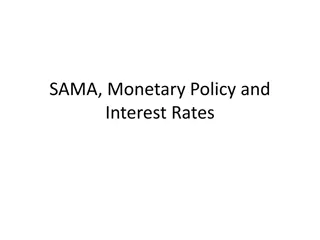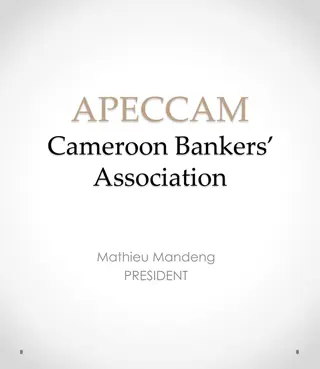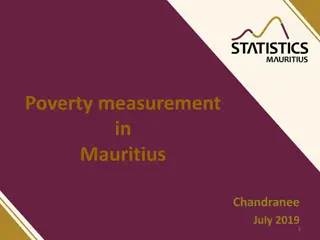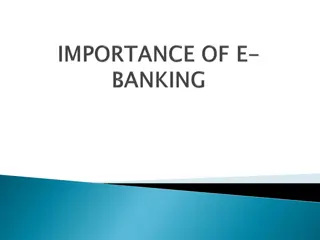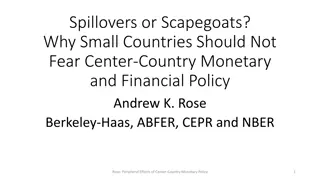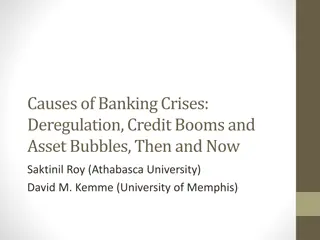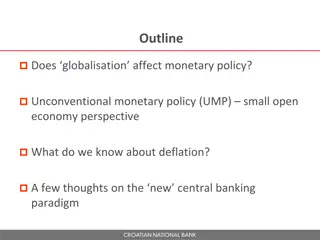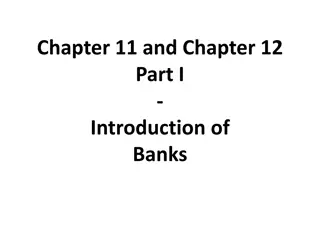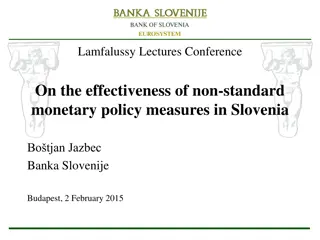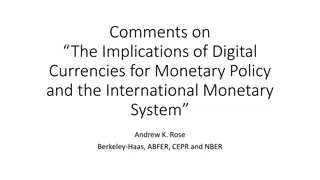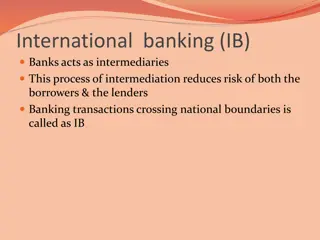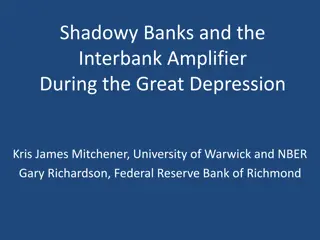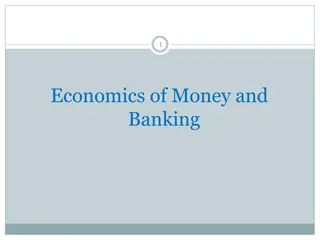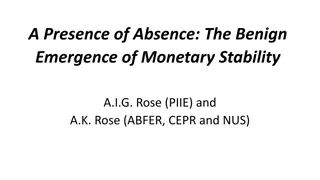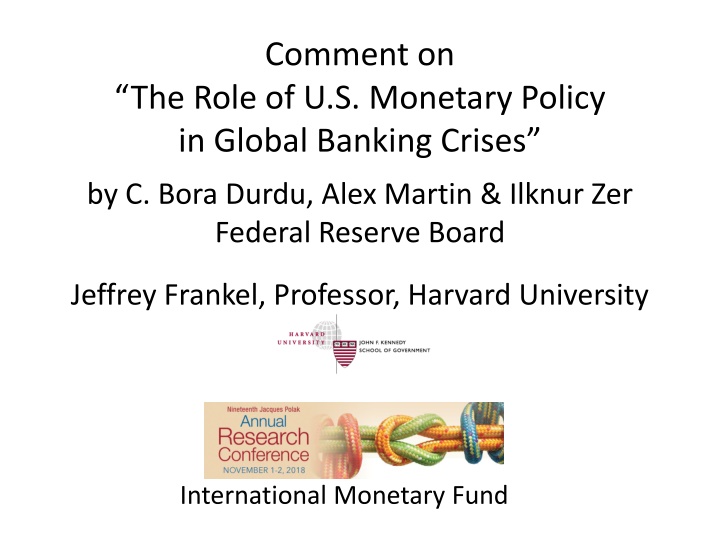
Role of U.S. Monetary Policy in Global Banking Crises
The paper explores how U.S. monetary policy affects global financial stability and the probability of banking crises in different countries. It analyzes data from 69 countries between 1870 and 2010, highlighting the impact of U.S. monetary tightening on countries with direct links to the U.S. versus those integrated globally. The study also delves into historical instances where U.S. interest rate hikes triggered emerging market crises, drawing comparisons to past events like the Volcker tightening in the 1980s and Greenspan's actions in the 1990s. Additionally, the research examines various economic literature and independent variables to understand the intricate relationship between U.S. monetary policy and global banking crises.
Download Presentation

Please find below an Image/Link to download the presentation.
The content on the website is provided AS IS for your information and personal use only. It may not be sold, licensed, or shared on other websites without obtaining consent from the author. If you encounter any issues during the download, it is possible that the publisher has removed the file from their server.
You are allowed to download the files provided on this website for personal or commercial use, subject to the condition that they are used lawfully. All files are the property of their respective owners.
The content on the website is provided AS IS for your information and personal use only. It may not be sold, licensed, or shared on other websites without obtaining consent from the author.
E N D
Presentation Transcript
Comment on The Role of U.S. Monetary Policy in Global Banking Crises by C. Bora Durdu, Alex Martin & Ilknur Zer Federal Reserve Board Jeffrey Frankel, Professor, Harvard University Annual Research Conference, Nov. 2, 2018 International Monetary Fund
Summary of the paper It examines the effect of U.S. monetary policy on global financial stability with data from 69 countries over the period 1870-2010. Finding: U.S. monetary tightening raises the probability of banking crises for those countries with direct linkages to the U.S., in the form either of trade links or large share of $-denominated liabilities. But if a country is integrated globally, without direct US exposure, the effect is ambiguous. 2
Motivation: Will rise in US interest rates trigger a new EM crisis? History 1980-82 Volcker tightening => international debt crisis. 1994 Greenspan tightening => Mexican peso crisis. Last 5 years of advance tremors, as US monetary ease reverses & interest rates rise: Spring 2013 taper tantrum Mid-2014 rise in $ & fall in commodity prices Mid-2015 RMB shock Mid-2018 Argentina-Turkey turbulence. 3
Some literature Rey (2013), Forbes & Warnock (2012), Jord , Schularick, Taylor & Ward (2018) US i => VIX => Capital outflows from EMs VIX allows including 2008 GFC on the list of US-origin EM crises. Prominent early examples include (1998) (1999). But it did not start with them. Among many possible precedents, consider Calvo, Leiderman & Reinhart (1992, 93, 94) = prescient warnings from the IMF Research Dept. CLR (1993) -- two years before the Mexican peso crisis: The importance of external factors suggests that a reversal of those conditions may lead to a future capital outflow. 4
Verdict on the paper: Good job. Congratulations, for example, on the length & breadth of the data set: Crises deemed unforecastable black swans with a data set of only a few decades or countries, can be seen as well inside the knowable probability distribution when using a 140-year sample of 69 countries. 5
Independent variables Shocks: increases in US 3-month T bill interest rates, including surprises, from Romer & Romer (2004) & others. interacted with cross-border integration bilateral vs. global. Trade integration: bilateral trade intensity with US Vs. overall trade/GDP, both instrumented by gravity-based geographical determinants. (I approve.) Financial integration: $ liabilities/GDP (choosing to focus on currency mismatch) Vs. overall capital account openness index of Chinn-Ito. Tried-and-true. 6
Dependent Variable Systemic banking crises from Reinhart & Rogoff (2009) in logit form. Also other crisis databases, as robustness check. Also, to test the channel of transmission: Portfolio capital outflows. Controls include: growth, inflation, and institutional quality. 7
Finding: EM exposure to US & $ increases crises, but general global exposure does not. The absence of negative effect for global exposure may seem surprising. The authors explanation is that perhaps open countries without direct bilateral US exposure benefit when capital flows are diverted away from those who do have it. Cavallo & Frankel (2008), which the authors kindly cite, found that trade/GDP openness reduced crisis vulnerability. Our interpretation was that a large tradable sector 1) gives hostages to trade partners, re-assuring creditors, or 2) reduces the percentage of demand contraction necessary to adjust to a given cut-off in foreign funding. 8
Sudden stops & currency crashes are less frequent in open economies Sudden Stops (SS1) and Currency Crises (Crash) by level of openness Sudden Stops & Currency Crashes by trade/GDP 350 292 300 250 Number of Episodes Less open Number of episodes 200 > Mean open < Mean open 150 127 100 More open 52 50 34 0 SS1 (86 events) Crashes (419 events) Sudden Stops (86 events) Currency Crashes (419 events) Cavallo & Frankel (2008), Does Openness to Trade Make Countries More Vulnerable to Sudden Stops, or Less? Using Gravity to Establish Causality, JIMF. 9
Quibble & suggestions Quibble: The authors use negative monetary policy shock to mean monetary expansion. It can be confusing, if negative makes you think of either adverse or a reduction in money supply. Suggestion for future work: Explore some possible transmission mechanisms -- The role of the VIX. The role of the $ exchange rate, esp. for $-debtors. The role of commodity prices, for commodity-exporters. 10
The authors policy conclusion Countries could diversify their global trade exposure and also reduce their dependence on $-denominated debt. The advice to reduce $-denominated debt has been standard at least since the 1990s. Some EM governments have heeded it, to their benefit, though EM corporates seem to have forgotten it, which is likely to cause trouble. The solution is not to borrow in other foreign currencies, but to issue local-currency debt, or equity, or FDI. Or do without. Final note: The advice to diversify trade away from the US suddenly seems wise, on other grounds! 11
Comment on The Role of U.S. Monetary Policy in Global Banking Crises by Durdu, Martin & Zer Jeffrey Frankel
References Calvo, Guillermo, Leo Leiderman & Carmen Reinhart (1993), "Capital Inflows and Real Exchange Rate Appreciation in Latin America: The Role of External Factors," IMF Staff Papers 40, no.1, March, pp.108-150. Cavallo, Eduardo & J.Frankel (2008), Does Openness to Trade Make Countries More Vulnerable to Sudden Stops, or Less? Using Gravity to Establish Causality, JIMF, Dec. Durdu, C. Bora, Alex Martin & Ilknur Zer (2018), The Role of U.S. Monetary Policy in Global Banking Crises Federal Reserve Board. Forbes, Kristin, & Frank Warnock (2012), Capital Flow Waves: Surges, Stops, Flight, and Retrenchment, Journal of International Economics. Jord , scar, Moritz Schularick, Alan M. Taylor, Felix Ward (2018), Global Financial Cycles and Risk Premiums, NBER WP 24677. Rey, H l ne (2013), Dilemma not Trilemma: The Global Financial Cycle and Monetary Policy Independence Proceedings - Economic Policy Symposium - Jackson Hole, Federal Reserve Bank of Kansas City, 13
Appendix: Trade openness may reduce EM vulnerability to crises Dependent variable: Crisis episodes. IV Probit Cavallo & Frankel (2008), Does Openness to Trade Make Countries More Vulnerable to Sudden Stops, or Less? Using Gravity to Establish Causality, JIMF. 14
Trade openness may reduce EM vulnerability to crises Dependent variable: Sudden stop. Ordinary Probit IV Probit Cavallo & Frankel (2008) 15
Dependent variable: Sudden Stops Probit IV Probit IV Linear IV-GLS RE (linear) -2.451 (0.813)** 0.196 (0.275) Openness t -0.53 (0.259)** -0.080 (0.217) -0.066 (0.022)*** 0.0066 (0.0182) -0.066 (0.026)** -0.006 (0.0155) Foreign Debt / GDP t-1 0.316 (0.195) 0.027 (0.0169) 0.591 (0.256)** 0.027 (0.0149)* Liability Dollarization t-1 -4.068 (1.297)** Current Account / GDP t-1 -7.386 (2.06)*** -0.317 (0.10)*** -0.317 (0.095)*** 778 1062 1040 Obs. 1040 * Statistically significant at 10%, **5%, and *** 1% Additional Controls: Constant term, Year FE, Regional Dummies, International Reserves / Months of Imports, Institutional Quality, GDP per capita, Short Term Debt, FDI/GDP, Dummy for Nominal Exchange Rate Rigidity. 16 Cavallo & Frankel (2008)
Dependent variable: Currency Crashes Probit -0.57 (0.269)** 0.23 (0.231) 0.027 (0.249) 0.13 (0.094) -0.26 (0.082)*** 557 IV Probit -1.73 (0.918)** 0.59 (0.373)* 0.18 (0.234) 0.22 (0.113)* -0.37 (0.099)*** 841 Openness t Foreign Debt / GDP t-1 Liability Dollarization t-1 Exchange Rate Rigidity Index t-1 Ln Reserves in Months of Imports t-1 Obs. Additional Controls: Constant term, Year FE, Regional Dummies, CA/GDP, Institutional Quality, GDP per capita, Short Term Debt, FDI/GDP. Cavallo & Frankel (2008) 17





